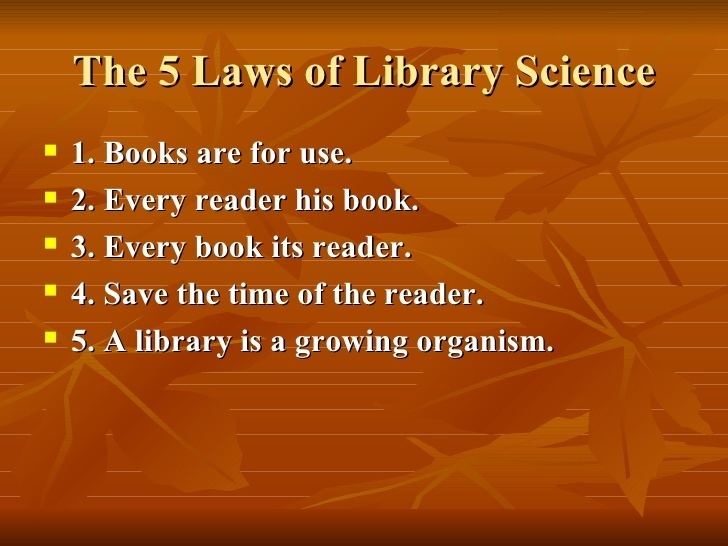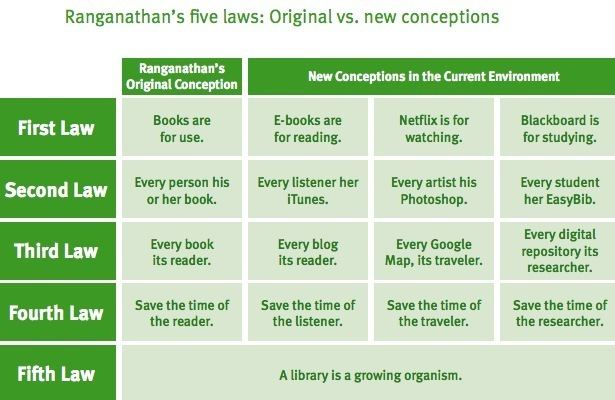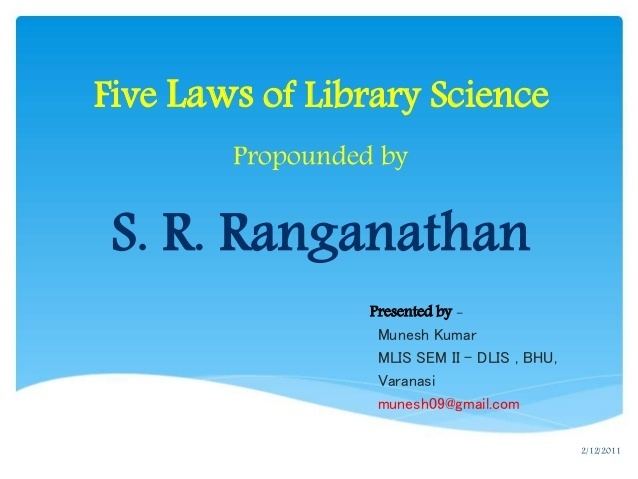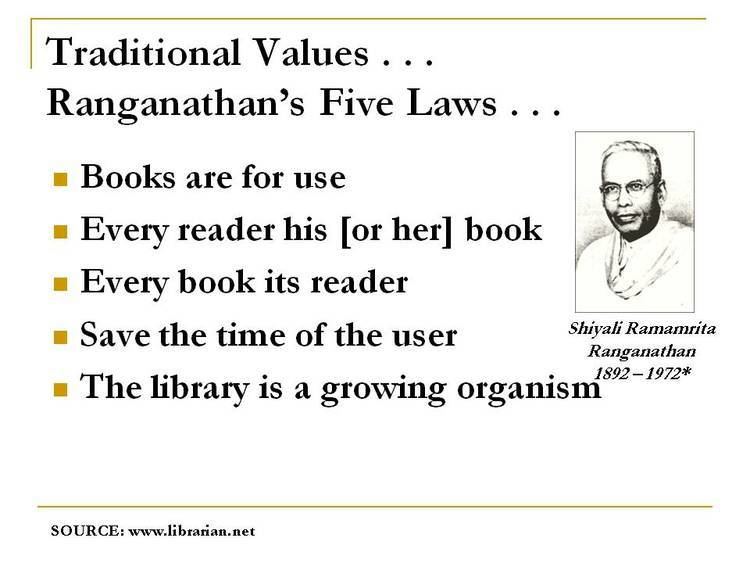 | ||
S r ranganathan s five laws of library science
The Five laws of library science is a theory proposed by S. R. Ranganathan in 1931, detailing the principles of operating a library system. Many librarians worldwide accept them as the foundations of their philosophy.
Contents
- S r ranganathan s five laws of library science
- First Law Books are for use
- Second Law Every reader hisher book
- Third Law Every book its reader
- Fourth Law Save the time of the reader
- Fifth Law The library is a growing organism
- Variants
- References

These laws are:
- Books are for use.
- Every reader his / her book.
- Every book its reader.
- Save the time of the reader.
- The library is a growing organism.

S r ranganathan s five laws of library science
First Law: Books are for use

The first law constitutes the basis for the library services. Dr. Ranganathan observed that books were often chained to prevent their removal and that the emphasis was on storage and preservation rather than use. He did not reject the notion that preservation and storage were important, but he asserted that the purpose of such activities was to promote use. Without user access to materials, there is little value in these items. By emphasizing use, Dr. Ranganathan refocused the attention of the field to access-related issues, such as the library's location, loan policies, hours and days of operation, as well as the quality of staffing and mundane matters like library furniture, temperature control and lighting.

The first law of library science "books are for use" means that books in libraries are not meant to be shut away from its users.
Second Law: Every reader his/her book
This law suggests that every member of the community should be able to obtain materials needed. Dr. Ranganathan felt that all individuals from all social environments were entitled to library service, and that the basis of library use was education, to which all were entitled. These entitlements were not without some important obligations for both libraries/librarians and library patrons. Librarians should have excellent first-hand knowledge of the people to be served. Collections should meet the special interests of the community, and libraries should promote and advertise their services extensively to attract a wide range of readers.
The second law of library science "every reader his/her book" means that librarians serve a wide collection of patrons, acquire literature to fit a vast collection of needs, do not judge what specific patrons choose to read. Everyone has different tastes and differences and we should respect that.
Third Law: Every book its reader
This principle is closely related to the second law, but it focuses on the item itself, suggesting that each item in a library has an individual or individuals who would find that item useful. Dr. Ranganathan argued that the library could devise many methods to ensure that each item finds its appropriate reader. One method involved the basic rules for access to the collection, most notably the need for open shelving.
The third law of library science "every book its reader" means a library's books have a place in the library even if a smaller demographic might choose to read it.
Fourth Law: Save the time of the reader
This law is a recognition that part of the excellence of library service is its ability to meet the needs of the library user efficiently. To this end, Dr.S.R Ranganathan recommended the use of appropriate business methods to improve library management. He observed that centralizing the library collection in one location provided distinct advantages. He also noted that excellent staff would not only include those who possess strong reference skills, but also strong technical skills in cataloging, cross-referencing, ordering, accessioning, and the circulation of materials.
The fourth law of library science "save the time of the user" means that all patrons should be able to easily locate the material they desire quickly and efficiently.
Fifth Law: The library is a growing organism
This law focused more on the need for internal change than on changes in the environment itself. Dr. Ranganathan argued that library organizations must accommodate growth in staff, the physical collection, and patron use. This involved allowing for growth in the physical building, reading areas, shelving, and in space for the catalog.
The fifth law of library science "the library is a growing organism" means that a library should be a continually changing institution, never static in its outlook. Books, methods, and the physical library should be updated over time.
Variants
Librarian Michael Gorman (past president of the American Library Association, 2005–2006), and Walt Crawford recommended the following laws in addition to Ranganathan's five in Future Libraries: Dreams, Madness, and Realities [American Library Association, 1995], (p. 8) Gorman later repeated them in his small book, Our Singular Strengths [American Library Association, 1998]. B. Shadrach (Indian Public Library Movement, 2015) proposed an alternative to Ranganathan's five laws at the Indian Public Libraries Conference, 2015 in New Delhi.
- Libraries serve humanity.
- Respect all forms by which knowledge is communicated.
- Use technology intelligently to enhance service.
- Protect free access to knowledge.
- Honor the past and create the future.
In 2004, librarian Alireza Noruzi recommended applying Ranganathan's laws to the Web in his paper, "Application of Ranganathan's Laws to the Web":
- Web resources are for use.
- Every user has his or her web resource.
- Every web resource its user.
- Save the time of the user.
- The Web is a growing organism.
In 2008, librarian Carol Simpson recommended that editing be done to Ranganathan's law due to media richness. The following were:
- Media are for use.
- Every patron his information.
- Every medium its user.
- Save the time of the patron.
- The library is a growing organism.
In 2015,B. Shadrach proposed an alternative set of laws adapted from Dr S R Ranganathan:
- Knowledge is for use in ‘all’ forms
- Every citizen has the right to access ‘all’ knowledge in 'all' forms
- Every piece of knowledge is for access by ‘all’ without discrimination of any kind
- Save the time of ‘all’ of the knowledge seekers
- A library or a knowledge system is one that evolves with time to achieve all of the above laws
In 2016 Dr Achala Munigal recommended that editing be done to Ranganathan's law due to introduction of Social Tools and their applications in Libraries
- Social Media is for use – increasingly in libraries by librarians
- Every user his/her Social Tool
- Every Social Tool its user
- Save time of user by providing information he/she seeks using the social tool he/she is familiar with.
- Social Media is a growing organism. With various tools and apps being introduced every day. Libraries are not brick and stone anymore. They serve members and non-members alike in terms of non-traditional library services; irrespective of space and time.
